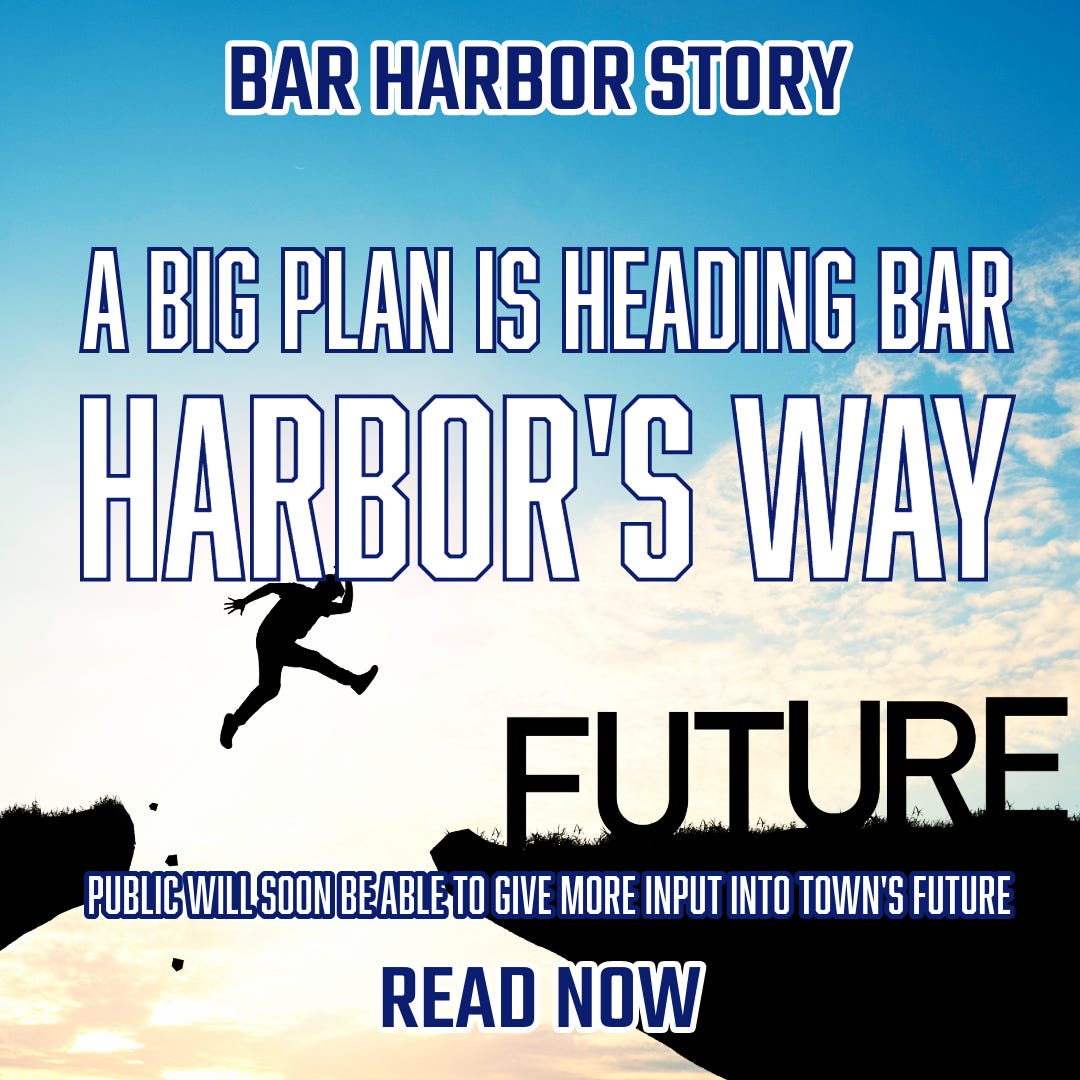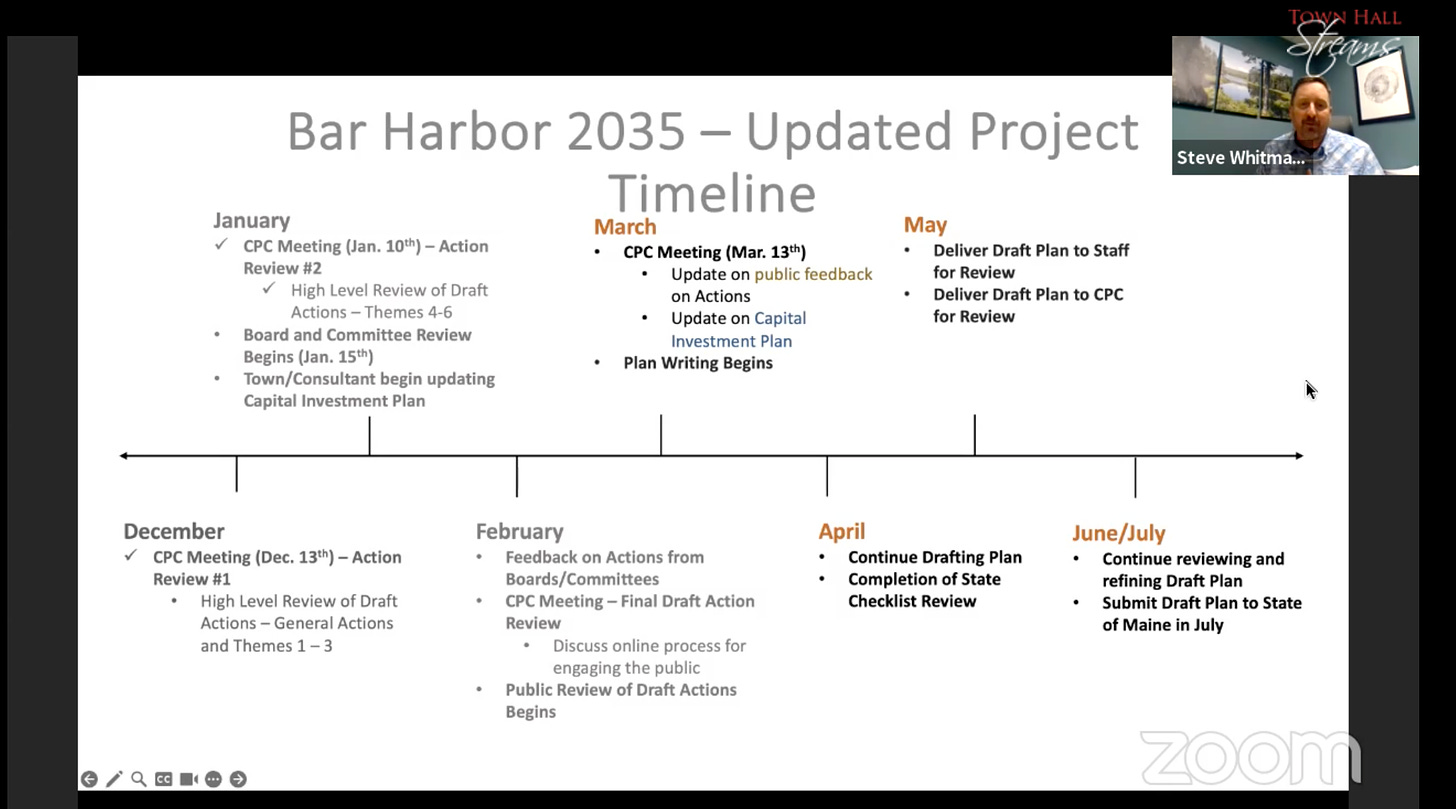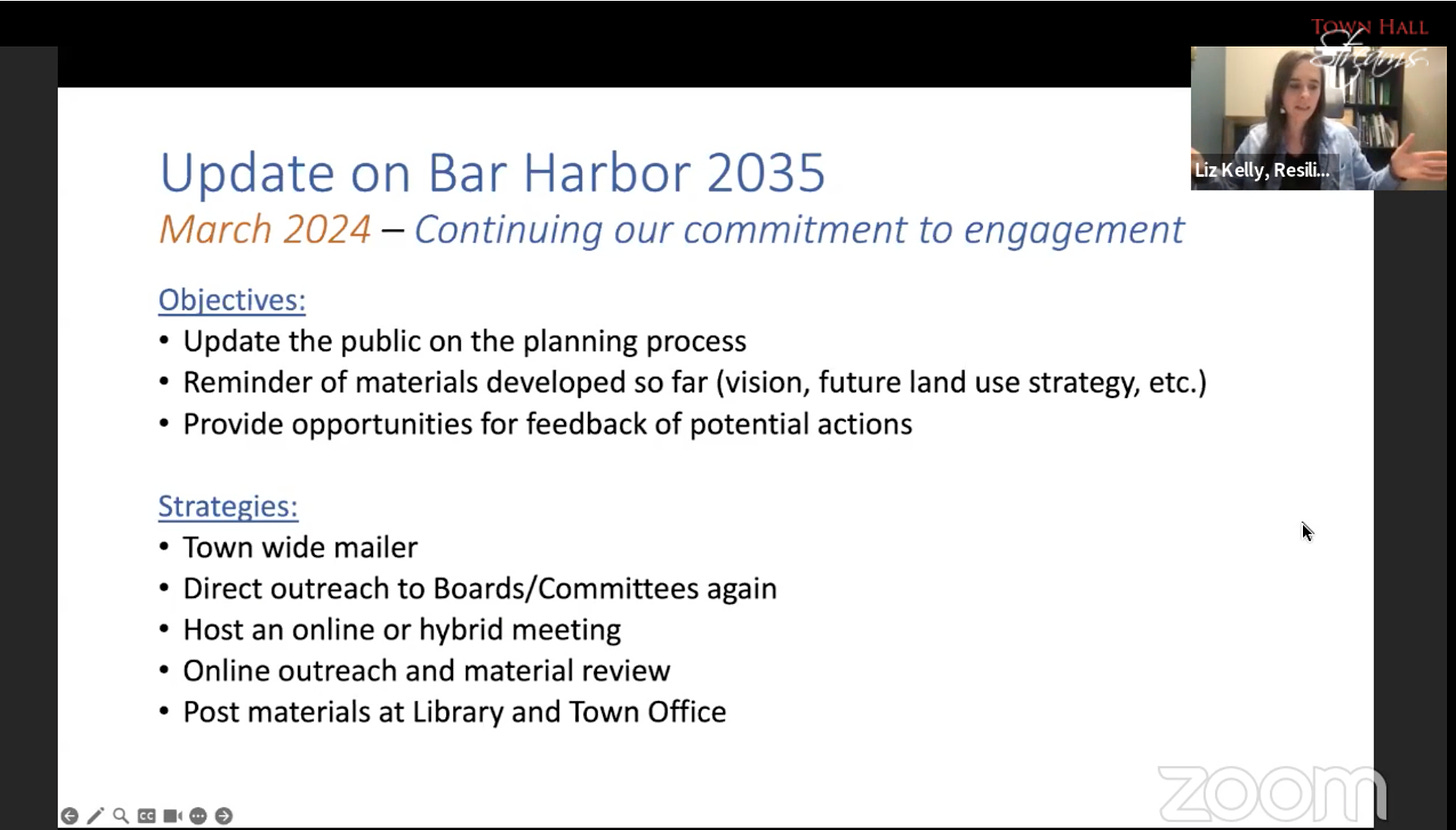A Big Plan Is Heading Bar Harbor's Way
Public will soon be able to give more input into town's future
BAR HARBOR—Fifteen Bar Harbor citizens, many of them on town boards and councilors have been meeting for more than two years with one task assigned them. This week, the group even met on Valentine’s Day.
Their job is to create a plan that steers Bar Harbor’s future. That plan has to be approved by the state and the voters.
The Comprehensive Plan Committee members were originally appointed by Town Council and they’ve met with Bar Harbor planning staff and consultants month after month to create that state-mandated Comprehensive Plan. And now?
“You’re almost there,” Steven Whitman of the consulting firm, Resilience Planning Group that’s been hired by Bar Harbor to facilitate the plan’s creation, told committee members. “You’re almost to that draft document.”
The last Comprehensive Plan was in 2007. The plans are meant to guide the town’s priorities and goals for about ten years from the plan’s start date, Planning Director Michele Gagnon has said.
The committee began meeting in December, 2021, and originally hoped to have a finalized plan in February 2023. Extra work on housing conditions and public engagement helped prolong the process.
On Wednesday, the committee spent approximately 80 minutes tweaking the latest edition of the draft themes and actions, which had been tweaked already by Whitman and town staff via comments and edits from other board and committee members and staff.
Many of the changes were easy, Whitman said. Some were good ideas that should be reflected in the plan, and some were a little detailed and needed to be discussed with the town staff and consultants.
“We’re happy to make any change that the CPC (Comprehensive Planning Committee) endorses,” Whitman said. “At the end of tonight, remember, these are still draft actions.” There are still chances to fine tune things, he said.
DIVERSE ECONOMY
Themes in the plan focus on housing, economic diversification, public transportation and pedestrian safety, infrastructure management, shared town resources, and regulation revision. The entire draft document has redlines, strikes, and additions, but initial discussion focused on Theme Five, which talks about a diverse economy.
That draft language of that three-page section, which is in the process of being tweaked, writes,
“Ensuring tourism management is equitable, it should benefit the whole and be perceived as being fair by most.
a. The benefits must not be limited to one segment of the community (i.e. business community) at the expense of another (i.e. year-round residents).
b. Ensuring tourism is sustainable for future generations, the negative impacts of tourism growth and development must not be so severe that the community loses the very qualities and assets that attract people to live and visit.
c. Ensuring tourism management is efficient and produces enough value for the efforts expended that it results in economic and other benefits.
d. Ensuring tourism is resilient and responds to changing environmental conditions so that the system continues to function when circumstances change.”
Committee member David Woodside worried that the current wording made it sound like members of the business community were not year-round residents. He also worried about how to measure or quantify how “tourism management is efficient and produces enough value for the efforts, expended that it results in economic and other benefits.”
Some members also wondered if the town had the ability to adopt a Tourism Development District that would have a tax that could then be used to offset municipal funding for tourism-related services and infrastructure?
Council Chair and committee member Valerie Peacock said that there wasn’t a way to make tourism management efficient in Bar Harbor because there is a “constant hashing out of who we are in the moment.” And the language in question is more about not just having constant dialogue but more about management.
Committee member Mike McKernan thought that the efficiency of tourism language was in reference to the meetings. Now, he thinks that possibly the facilitated meetings should be a tactical item nested within the piece rather than as presented.
“I think efficiency is a magical fairy land,” Peacock said. Words and concepts can be difficult to define in relationship to the plan.
“So is value, too. Value? Profit? Value? Time well spent? It could be either,” McKernan said.
Committee member and Planning Board Secretary Elissa Chesler wondered if the language was really about ensuring whether the measures potentially adopted (data gathering, staff time, and so on) were getting a return for the costs for doing that tourism management work.
THEME 1 – HOUSING SOLUTIONS
Housing policy actions make it very clear what the town can do and what others can do to deal with the housing issues in town, Chesler said of the first theme. “It’s a question of is this enough of an opinion to get where people think we need to go at this time?”
The housing section, school board member and committee member Misha Mytar said, is more specific than other themes, which makes her have more questions about it. She wasn’t sure if it wasn’t a bit too detailed. She also worried that the first bullet point “develop housing targets and track progress” might be beyond the capacity of the town.
“It seems like too much for the scale of the plan we have,” Mytar said.
Whitman said that the section has the most detail because the town spent an additional $25,000 for RKG to study housing. It might raise more questions, he said, because they don’t want to lock the town in on how to implement those points.
Housing and Community Planner Cali Martinez said she matched the section’s items to the town’s Housing Priorities Framework and that not all the work can or will be tackled at once, but would be prioritized. That work isn’t prioritized in the plan, but is in the Housing Priorities Framework.
Committee member Jim Mahoney said he thinks they’ve done a good job at conveying the need for more housing, but he wonders about the balance. There is density still that can be built within the land use ordinance as it exists, he said. There are market forces at play, which prevent that. He wants to make sure there’s a balance between density and the existence of current neighborhoods and their culture if zoning and building rules are changed.
Martinez said the planning department is looking at the data of the existing neighborhoods and districts and their current uses to try to keep that cohesion and culture of each.
THEME 3 – PEOPLE-CENTERED TRANSPORTATION
Mytar worried about a lack of clear strategies to deal with traffic congestion. Councilor and committee member Kyle Shank suggested adding more congestion language to one of the points in the theme.
CONTINUED ENGAGEMENT
Liz Kelly, also of Resilient Planning Group (RPG), said that they’d like to go back out and update the community on the planning process as well as provide opportunities for feedback.
Town staff and RPG are going to create a town-wide mailer, outreach directly to boards and committees, and host an online or hybrid meeting as well as have online outreach and post materials at the library and town office.
John Kelly was absent. The only member of the public attending in person was Ruth Eveland. The meeting was also available via Town Hall Streams and Zoom.
LINKS TO LEARN MORE
To see the last draft and agenda
Website dedicated to Bar Harbor’s Comprehensive Plan project.
Existing Conditions Analysis Report
Our December 15 story about the last Comprehensive Planning Committee meeting and discussion.








